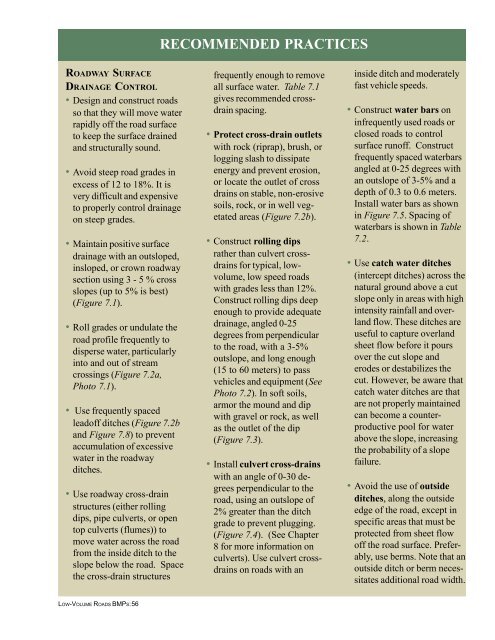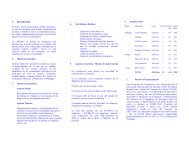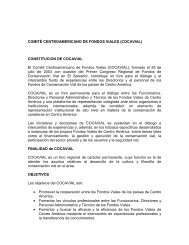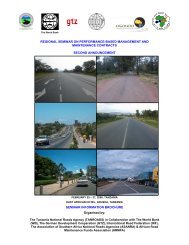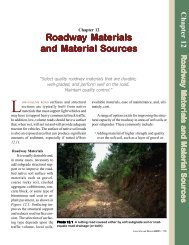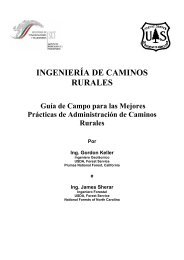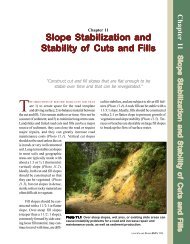Create successful ePaper yourself
Turn your PDF publications into a flip-book with our unique Google optimized e-Paper software.
RECOMMENDED PRACTICES<br />
ROADWAY SURFACE<br />
DRAINAGE CONTROL<br />
• Design and construct roads<br />
so that they will move water<br />
rapidly <strong>of</strong>f the road surface<br />
to keep the surface drained<br />
and structurally sound.<br />
• Avoid steep road grades in<br />
excess <strong>of</strong> 12 to 18%. It is<br />
very difficult and expensive<br />
to properly control drainage<br />
on steep grades.<br />
• Maintain positive surface<br />
drainage with an outsloped,<br />
insloped, or crown roadway<br />
section using 3 - 5 % cross<br />
slopes (up to 5% is best)<br />
(Figure 7.1).<br />
• Roll grades or undulate the<br />
road pr<strong>of</strong>ile frequently to<br />
disperse water, particularly<br />
into and out <strong>of</strong> stream<br />
crossings (Figure 7.2a,<br />
Photo 7.1).<br />
• Use frequently spaced<br />
lead<strong>of</strong>f ditches (Figure 7.2b<br />
and Figure 7.8) to prevent<br />
accumulation <strong>of</strong> excessive<br />
water in the roadway<br />
ditches.<br />
• Use roadway cross-drain<br />
structures (either rolling<br />
dips, pipe culverts, or open<br />
top culverts (flumes)) to<br />
move water across the road<br />
from the inside ditch to the<br />
slope below the road. Space<br />
the cross-drain structures<br />
frequently enough to remove<br />
all surface water. Table 7.1<br />
gives recommended crossdrain<br />
spacing.<br />
• Protect cross-drain outlets<br />
with rock (riprap), brush, or<br />
logging slash to dissipate<br />
energy and prevent erosion,<br />
or locate the outlet <strong>of</strong> cross<br />
drains on stable, non-erosive<br />
soils, rock, or in well vegetated<br />
areas (Figure 7.2b).<br />
• Construct rolling dips<br />
rather than culvert crossdrains<br />
for typical, lowvolume,<br />
low speed roads<br />
with grades less than 12%.<br />
Construct rolling dips deep<br />
enough to provide adequate<br />
drainage, angled 0-25<br />
degrees from perpendicular<br />
to the road, with a 3-5%<br />
outslope, and long enough<br />
(15 to 60 meters) to pass<br />
vehicles and equipment (See<br />
Photo 7.2). In s<strong>of</strong>t soils,<br />
armor the mound and dip<br />
with gravel or rock, as well<br />
as the outlet <strong>of</strong> the dip<br />
(Figure 7.3).<br />
• Install culvert cross-drains<br />
with an angle <strong>of</strong> 0-30 degrees<br />
perpendicular to the<br />
road, using an outslope <strong>of</strong><br />
2% greater than the ditch<br />
grade to prevent plugging.<br />
(Figure 7.4). (See <strong>Chapter</strong><br />
8 for more information on<br />
culverts). Use culvert crossdrains<br />
on roads with an<br />
inside ditch and moderately<br />
fast vehicle speeds.<br />
• Construct water bars on<br />
infrequently used roads or<br />
closed roads to control<br />
surface run<strong>of</strong>f. Construct<br />
frequently spaced waterbars<br />
angled at 0-25 degrees with<br />
an outslope <strong>of</strong> 3-5% and a<br />
depth <strong>of</strong> 0.3 to 0.6 meters.<br />
Install water bars as shown<br />
in Figure 7.5. Spacing <strong>of</strong><br />
waterbars is shown in Table<br />
7.2.<br />
• Use catch water ditches<br />
(intercept ditches) across the<br />
natural ground above a cut<br />
slope only in areas with high<br />
intensity rainfall and overland<br />
flow. These ditches are<br />
useful to capture overland<br />
sheet flow before it pours<br />
over the cut slope and<br />
erodes or destabilizes the<br />
cut. However, be aware that<br />
catch water ditches are that<br />
are not properly maintained<br />
can become a counterproductive<br />
pool for water<br />
above the slope, increasing<br />
the probability <strong>of</strong> a slope<br />
failure.<br />
• Avoid the use <strong>of</strong> outside<br />
ditches, along the outside<br />
edge <strong>of</strong> the road, except in<br />
specific areas that must be<br />
protected from sheet flow<br />
<strong>of</strong>f the road surface. Preferably,<br />
use berms. Note that an<br />
outside ditch or berm necessitates<br />
additional road width.<br />
LOW-VOLUME ROADS BMPS:56


